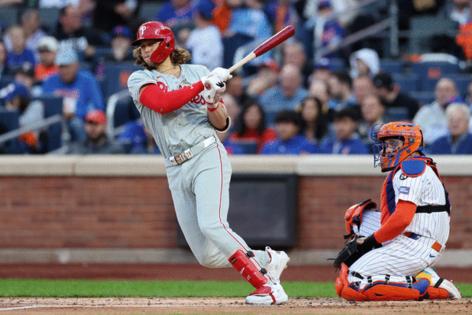David Murphy: Phillies' crushing NLDS loss raises questions about long-term futures of Alec Bohm, Brandon Marsh, even Rob Thomson
Published in Baseball
NEW YORK — It was not supposed to end this way. As little as three months ago, the suggestion would have seemed a setup for a punch line. Carlos Estévez, crouched in front of the Citi Field mound, a wince on his face, casting a fearful look over his shoulder, watching Francisco Lindor’s sixth-inning grand slam disappear over the wall in right-center field, realizing that the tide had irrevocably turned, and that the Phillies’ most promising season in years would soon be over after a mere four games.
A loss as calamitous as this one does not leave much room for granular details. It doesn’t matter how it went down, only that it did. If you watched Game 4, you know what happened. You know it was roughly the same as what had happened in each of the Phillies’ previous five postseason games. Their lineup failed to generate comfortable leads, and their bullpen failed to maintain the flew slim ones. More relevant is the question of why those two things continue to happen, and how it might be solved. It is a big question. It is an important question. But it is neither the biggest nor most important unknown.
No, the most important unknown in the wake of the Phillies’ 4-1 loss to the Mets in Game 4 of the NLDS came into focus a couple of innings before it was officially over. As Lindor stepped on second base for the force out to end the eighth inning, a sellout crowd of 44,000 of the most joy-starved fans in the sporting universe exploded. The roar that engulfed Citi Field quickly transitioned to history’s most rousing and unencumbered sing-along of Billy Joel’s Piano Man, the chorus engulfing the field as the 2024 Phillies wandered back out for what figured to be their final three outs of defense.
Is this really happening? More importantly, is it the kind of thing that is in danger of continuing to happen? Was this simply matter of a more talented team and successful organization running into the postseason’s inevitable team-on-fire? Will it go down as a hiccup, a speed bump, a smirch on the record of an era that will eventually yield that long-sought title? Or will it go down as something different? The natural next step for a team that has already peaked, its best chance at glory disappearing slightly further into the rearview?
You can only hope that there is nothing symbolic in the fact that the Mets are the team that has sparked these questions. Back in June and July, if you’d attempted to concoct a scenario that would inflict maximum pain on the Phillies and their fan base, it would have looked a lot like this. Kyle Schwarber swinging at strike three against Edwin Díaz, a blue-and-orange mob forming around second base, a giant apple rising from its black-clad burrow in center field.
Three weeks before the Phillies acquired Estévez at the trade deadline in a move they thought would fortify their standing as NL title favorites, the Mets were 15 games out of first place, two games under .500, embarking on a road that seemed a decent bet to end with themselves as deadline sellers. Pete Alonso, La Candelita, OMG, all of it seemed so unserious it was almost enjoyable. The Mets would never stop Metsing.
Now? We have witnessed what may have been the October breakout of a future star, with Mets third baseman Mark Vientos owning this series in a way that none of the Phillies $20-plus million superstars could come close to replicating. We have seen Lindor not only validate those MVP chants but raise the possibility that he might be the kind of player who can carve his name into postseason legend. We are left to contemplate a remarkable possibility: that these Mets really might have what it takes to win a World Series in a year that was supposed to be the Phillies’ best chance yet.
The immediate aftermath of a loss like this is no time to render definitive judgments. It is too early to say that things must change. It is not too early to say changes must be considered. The trend line stretches further back than Games 6 and 7 of last year’s NLCS loss to the Diamondbacks. The Phillies are now 2-5 in their last seven postseason games after going 14-4 in the 18 games before them.
Dave Dombrowski and Rob Thomson must think long and hard about the construction of this lineup. Is this really the right mix of players around the ones who will need to continue to serve as its centerpieces? The bottom half of the order was practically nonexistent dating to well before the start of this series. Alec Bohm, Bryson Stott, Brandon Marsh, Johan Rojas — what exactly do the Phillies have in these players? Which ones have earned a permanent spot alongside the Bryce Harpers and Schwarbers and Trea Turners? How might they swap out the ones who haven’t?
This is assuming, of course, that Thomson himself is guaranteed to return for his third full season at the helm. He should be. I am pretty sure of that. You do not make that change at this point in time. In an offseason in which a lot else has to change, the Phillies what Thomson brings from a human management standpoint. Yet the manager left his critics plenty of openings for how he handled both his pitching staff and his lineup throughout this series.
On Wednesday night, those were the questions that swirled as the bass line of OMG thumped through Citi Field, October’s newest darlings lingering long past the final out, as the game’s former fancy new things slunk silently to the visitors’ clubhouse.
©2024 The Philadelphia Inquirer. Visit inquirer.com. Distributed by Tribune Content Agency, LLC.







Comments